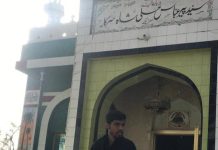Peshawar: The rich archaeological heritage of Khyber Pakhtunkhwa remains unexplored due to a shortage of staff at the Directorate of Archeology and Museums, archaeology experts say.
The province has more than 6000 archaeological sites , but the number of staff available to explore these is far from enough, according to the directorate’s top official.
“The Directorate of Archaeology and Museums has four engineers and 12 archaeologists and field officers. We need 100 and 300 of these respectively,” Abdul Samad Khan, who heads the Directorate of Archaeology and Museums, told News Lens Pakistan.
The department also faces a shortage of curators, assistant curators, gallery assistants, research officers and assistant research officers, Khan said.
“Maintaining an archaeological site requires teamwork involving all these,” he said.
Until 2010 when the 18th Amendment to the Constitution made it a provincial subject, the Directorate of Archeology and Museums was a federal entity. According to the staff at the Directorate, they haven’t had any promotion since the devolution in 2010. This means no new positions have been opened up for new staff that the Directorate desperately needs.
Nawaz ud Din, a gallery assistant at the Directorate, said that most of the existing staff hadn’t had any promotions for nearly a decade. He said he had been working on the same post for the past 8 years. “It is the same situation with our other colleagues at the Directorate.”
“A summary proposing creation of more than 800 different new posts had been forwarded to the finance department by the Directorate of Archeology and Museums but the [provincial] Finance Department has shelved it citing financial crisis,” said Tariq Khan, Additional Secretary at Department of Tourism, Sports, Archaeology, Youth Affairs & Museums.
Tariq Khan said a similar proposal was rejected by the Finance Department in the fiscal year 2015-16.
He, however, sounded sanguine about the shortage of staff saying it was “a normal problem” in every department of the province and should not to be taken “seriously.”
Tariq Khan said that the proposal was rejected twice by Finance Department – for the fiscal year 2015-16 and 2016-17 – and both times the Directorate was told to send it again the next year. He hoped that it would be entertained next year.
An official at the Department who wished to remain unnamed because of the nature of information shared said that the Finance Department had rejected their proposal for an ‘invalid’ reason. He didn’t say what the reason exactly was but added that the bureaucracy (Finance Department) had a similar “non-cooperative behaviour” towards other departments in the province.
Jawad Aziz, a culture officer at United Nations Educational, Scientific and Cultural Organization (UNESCO) said that maintaining 6000 sites and 12 museums with the little staff was impossible. He said among these archaeological sites there those declared as “world heritage sites” by UNESCO.
Aziz said that UNESCO was helpless because it could not directly play any role in the maintenance of sites.
“UNESCO cannot intervene in the affairs of the concerned departments nor can it do anything to overcome the shortage of staff due of limited funds,” said Aziz.
However, he said, UNESCO conducted workshops for students, teachers and the public to create awareness about the significance of archaeological sites and their maintenance.




If government cannot pay, who else will? Still, can heritage tourism be promoted through private public partnership? Or City District Governments should be involved in the maintenance of site.
We can learn from the international experience how best to do it.
But the question is whether we really want to protect the sites or inflates our departments and institutional egos?